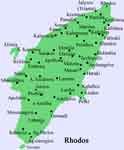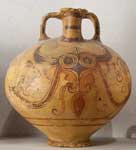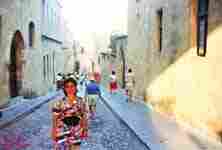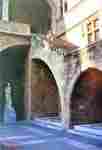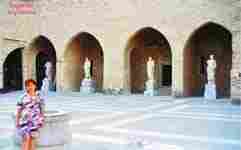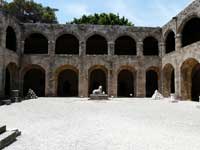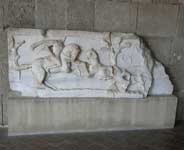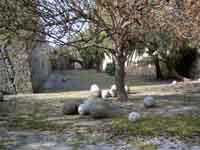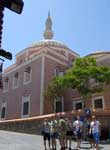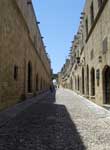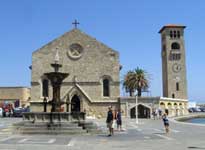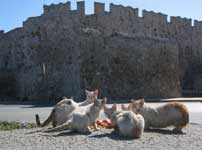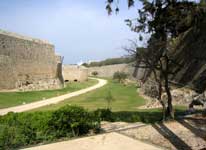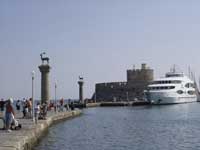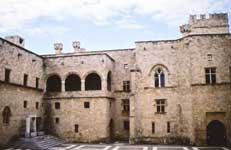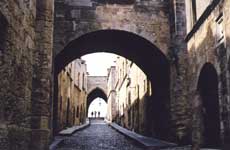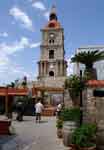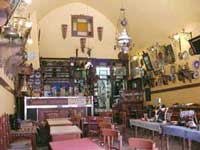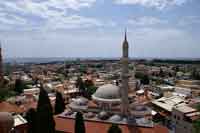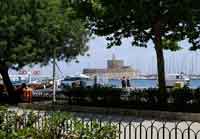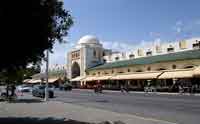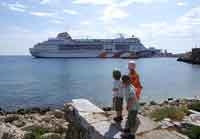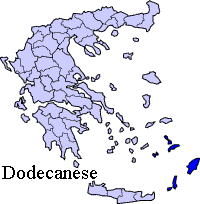
Rhodes or Rodos (Greek: Ρόδος, Ródos, [ˈroðos]) is the principal city and a former municipality on the island of Rhodes, in the Dodecanese, Greece. Since the 2011 local government reform it is part of the municipality Rhodes, of which it is the seat and a municipal unit.[1] It has a population of approximately 80,000. Rhodes has been famous since antiquity as the site of Colossus of Rhodes, one of the Seven Wonders of the World. The citadel of Rhodes, built by the Hospitalliers, is one of the best preserved medieval towns in Europe which in 1988 was designated as a UNESCO World Heritage Site. The City of Rhodes is a popular international tourist destination.
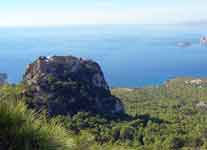
Geography
The city of Rhodes is situated in the north-east tip of the island and forms a triangle from north to south. It is the smallest municipality of the island in terms of land area and the largest in population. It borders with the Aegean Sea in the north, the east and the west and with the municipalities of Ialysos and Kallithea in the south.
History
The island of Rhodes is at a crossroads between Europe, the Middle East, and Africa. This has given the city and the island many different identities, cultures, architectures, and languages over its long history. Its position in major sea routes has given Rhodes a very rich history. The island has been inhabited since about 4000 BC (Neolithic Period).[2]
Classical Period

|
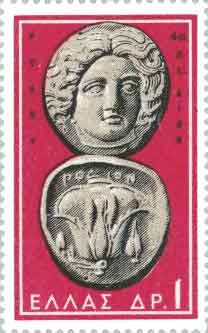
Rhodes Coin, 4th century BC |
The Persians invaded and overran the island, but they were in turn defeated by forces from Athens in 478 BC. The Rhodian cities joined the Athenian League. When the Peloponnesian War broke out in 431 BC, Rhodes remained largely neutral, although it remained a member of the League. The war lasted until 404 BC, but by this time Rhodes had withdrawn entirely from the conflict and decided to go her own way.
In 408 BC, the cities united to form one territory. They built the city of Rhodes, a new capital on the northern end of the island. Its regular plan was, according to Strabo, superintended by the Athenian architect Hippodamus.
In 357 BC, the island was conquered by the king Mausolus of Caria, then it fell again to the Persians in 340 BC. Their rule was also short.
Hellenistic age
Rhodes then became a part of the growing empire of Alexander the Great in 332 BC, after he defeated the Persians.[citation needed]
The Colossus of Rhodes, as depicted in an artist's impression of 1880
Following the death of Alexander, his generals vied for control of the kingdom. Three—Ptolemy, Seleucus, and Antigonus—succeeded in dividing the kingdom among themselves. Rhodes formed strong commercial and cultural ties[24] with the Ptolemies in Alexandria, and together formed the Rhodo-Egyptian alliance that controlled trade throughout the Aegean in the 3rd century BC.
The city developed into a maritime, commercial and cultural center; its coins circulated nearly everywhere in the Mediterranean. Its famous schools of philosophy, science, literature and rhetoric shared masters with Alexandria: the Athenian rhetorician Aeschines, who formed a school at Rhodes; Apollonius of Rhodes;[25] the observations and works of the astronomers Hipparchus and Geminus, the rhetorician Dionysius Thrax. Its school of sculptors developed, under Pergamese influence, a rich, dramatic style that can be characterized as "Hellenistic Baroque". Agesander of Rhodes, with two other Rhodian sculptors, carved the famous Laocoön group, now in the Vatican Museums, and the large sculptures rediscovered at Sperlonga in the villa of Tiberius, probably in the early Imperial period.
In 305 BC, Antigonus directed his son, Demetrius, to besiege Rhodes in an attempt to break its alliance with Egypt. Demetrius created huge siege engines, including a 180 ft (55 m) battering ram and a siege tower called Helepolis that weighed 360,000 pounds (163,293 kg). Despite this engagement, in 304 BC after only one year, he relented and signed a peace agreement, leaving behind a huge store of military equipment. The Rhodians sold the equipment and used the money to erect a statue of their sun god, Helios, the statue since called the Colossus of Rhodes.[citation needed]
Throughout the 3rd century BC, Rhodes attempted to secure her independence and her commerce, most especially her virtual control over the grain trade in the eastern Mediterranean. Both of these goals were dependent upon no one of the three great Hellenistic states achieving dominance, and consequently the Rhodians pursued a policy of maintaining a balance of power among the Antigonids, Seleucids and Ptolemies, even if that meant going to war with her traditional ally, Egypt. To this end they employed as leverage their economy and their excellent navy, which was manned by proverbially the finest sailors in the Mediterranean world: "If we have ten Rhodians, we have ten ships."[citation needed] The Rhodians also established their dominance on the shores of Caria across from their island, which became known as the "Rhodian Peraia". It extended roughly from the modern city of Muğla (ancient Mobolla) in the north and Kaunos bordering Lycia in the south, near the present-day Dalyan, Turkey.
Rhodes successfully carried on this policy through the course of the third century BC, an impressive achievement for what was essentially a democratic state. By the end of that period, however, the balance of power was crumbling, as declining Ptolemaic power made Egypt an attractive target for Seleucid ambitions. In 203/2 BC the young and dynamic kings of Antigonid Macedon and Seleucid Asia, Philip V and Antiochus III, agreed to accept—at least temporarily—their respective military ambitions, Philip's campaign in the Aegean and western Anatolia and Antiochus’ final solution of the Egyptian question. Heading a coalition of small states, the Rhodians checked Philip's navy, but not his superior army. Without a third power to which to turn, the Rhodians appealed in 201 BC to the Roman Republic.
Medieval gate at the Acropolis of Lindos
Despite being exhausted by the titanic struggle against Hannibal (218–201 BC) the Romans agreed to intervene, having already been stabbed in the back by Philip during the war against Carthage. The Senate saw the appeal from Rhodes and her allies as the opportunity to pressure Philip. The result was the Second Macedonian War (200–196 BC), which ended Macedon's role as a major player and preserved Rhodian independence.[citation needed] Rhodian influence in the Aegean was cemented through the organization of the Cyclades into the Second Nesiotic League under Rhodian leadership.
The Romans actually withdrew from Greece after the end of the conflict, but the resulting power vacuum quickly drew in Antiochus and subsequently the Romans, who defeated (192–188 BC) the last Mediterranean power that might even vaguely threaten their predominance. Having provided Rome with valuable naval help in her first foray into Asia, the Rhodians were rewarded with territory and enhanced status.[citation needed] The Romans once again evacuated the east – the Senate preferred clients to provinces – but it was clear that Rome now ruled the world and Rhodian autonomy was ultimately dependent upon good relations with them.
And those good graces soon evaporated in the wake of the Third Macedonian War (171–168 BC). In 169 BC, during the war against Perseus, Rhodes sent Agepolis as ambassador to the consul Quintus Marcius Philippus, and then to Rome in the following year, hoping to turn the Senate against the war. Rhodes remained scrupulously neutral during the war, but in the view of hostile elements in the Senate she had been a bit too friendly with the defeated King Perseus. Some actually proposed declaring war on the island republic, but this was averted. In 164, Rhodes became a permanent ally of Rome, ending an independence that no longer had any meaning. It was said that the Romans ultimately turned against the Rhodians because the islanders were the only people they had encountered who were more arrogant than themselves.[citation needed]
After surrendering its independence Rhodes became a cultural and educational center for Roman noble families and was especially noted for its teachers of rhetoric, such as Hermagoras and the unknown author of Rhetorica ad Herennium. At first, the state was an important ally of Rome and enjoyed numerous privileges, but these were later lost in various machinations of Roman politics. Cassius eventually invaded the island and sacked the city. In the early Imperial period Rhodes became a favorite place for political exiles.[28]
In the 1st century AD, the Emperor Tiberius spent a brief term of exile on Rhodes. Saint Paul brought Christianity to people on the island. Rhodes reached her zenith in the 3rd century.
In ancient times there was a Roman saying: "hic Rhodus, hic salta!"—"Here is Rhodes, jump here", an admonition to prove one's idle boasts by deed rather than talk. It comes from an Aesop's fable called "The Boastful Athlete" and was cited by Hegel, Marx, and Kierkegaard.
Roman period
In 164 BC, Rhodes became part of the Roman province of Asia.[3] It was able to keep its beauty and develop into a leading center of learning for arts and science. Many traces of the Roman period still exist throughout the city and give us an insight into the level of civilization at the time. According to Acts 21:1, the Apostle Paul stopped at Rhodes near the end of his third missionary journey.
Byzantine period
In 395 with the division of the Roman Empire, the long Byzantine period began for Rhodes. In Late Antiquity, the island was the capital of the Roman province of the Islands, headed by a praeses (hegemon in Greek), and encompassing most of the Aegean islands, with twenty cities. Correspondingly, the island was also the metropolis of the ecclesiastical province of Cyclades, with eleven suffragan sees.
Beginning from ca. 600 AD, its influence in maritime issues was manifested in the collection of maritime laws known as "Rhodian Sea Law" (Nomos Rhodion Nautikos), accepted throughout the Mediterranean and in use throughout Byzantine times (and influencing the development of admiralty law up to the present).[citation needed] In 622/3, during the climactic Byzantine–Sasanian War of 602–628, Rhodes was captured by the Sasanian navy.
Rhodes was occupied by the Islamic Umayyad forces of Caliph Muawiyah I in 654, who carried off the remains of the Colossus of Rhodes.[ The island was again captured by the Arabs in 673 as part of their first attack on Constantinople. When their fleet was destroyed by Greek fire before Constantinople and by storms on its return trip, however, the island was evacuated in 679/80 as part of the Byzantine–Umayyad peace treaty.[35] In 715 the Byzantine fleet dispatched against the Arabs launched a rebellion at Rhodes, which led to the installation of Theodosios III on the Byzantine throne.
From the early 8th to the 12th centuries, Rhodes belonged to the Cibyrrhaeot Theme of the Byzantine Empire, and was a centre for shipbuilding and commerce. In c. 1090, it was occupied by the forces of the Seljuk Turks, not long after the Battle of Manzikert. Rhodes was recaptured by the Emperor Alexios I Komnenos during the
First Crusade.
Part of the late medieval fortifications of Rhodes
As Byzantine central power weakened under the Angeloi emperors (1185–1204), in the first half of the 13th century, Rhodes became the centre of an independent domain under Leo Gabalas and his brother John, until it was occupied by the Genoese in 1248–1250. The Genoese were evicted by the Empire of Nicaea, after which the island became a regular province of the Nicaean state (and after 1261 of the restored Byzantine Empire). In 1305, the island was given as a fief to Andrea Morisco, a Genoese adventurer who had entered Byzantine service. Between 1300 and 1314, however, Rhodes was controlled by Menteşe, an Anatolian beylik.
Knights' period
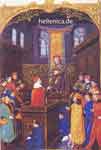
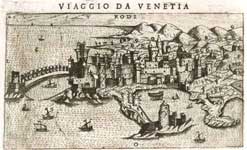
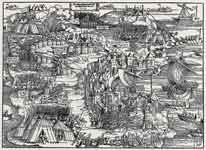
Siege of Rhodes, Hans Sebald Beham 1522
The Knights Hospitallers captured and established their headquarters on Rhodes when they left Italy after the persecution of the Knights Templar in 1307. Pope Clement V confirmed the Hospitallers possession of the Island in 1309. The Knights remained on the Island for the next two centuries.
In 1444, the Mamluk fleet of Egypt laid a siege to Rhodes, but the Knights aided by the Burgundian naval commander Geoffroy de Thoisy beat off the Muslim attack.
After the Fall of Constantinople in 1453 the Ottoman Empire began a rapid expansion and in 1480 Sultan Mehmet launched an invasion of Rhodes commanded by Mesic Pasha. The defenders repelled Turkish attacks from both landward and seaward sides and the invaders left the Island in defeat. The defeat halted a concurrent invasion of the Italian peninsula by Ottoman forces and prevented possible Muslim incursion and control of Western Europe.
After the Ottoman defeat in 1480 the Knights Grand Master, Fabrizio Del Carreto, oversaw the strengthening of the cities over the next few decades. By the time of his death in 1521 Rhodes possessed the strongest fortifications of any Christian Bastion in the World. The continued Naval attack launched from Rhodes on Muslim Merchants until 1522 the newly enthroned Sultan Suleiman the Magnificent led a second Siege of Rhodes (1522).
The vastly outnumbered Knights made a spirited defense of the city and inflicted heavy casualties upon the Ottoman besiegers. In December 1522 the Knights and Suleiman came to terms and the Knights were allowed to leave the city with all the wealth they could carry, in return there would be no retribution upon the inhabitants of the city and they would be allowed to continue to freely practice Christianity. On January 1, 1523 the Knights departed from the island, leaving it to Ottoman control.
Ottoman period
View of Suleiman Mosque.
View of the Market ("Nea Agora") of Mandraki, built during the Italian period.
In the Ottoman era, new buildings were constructed: mosques, public baths and mansions for the new patrons. The Greeks were forced to abandon the fortified city and move to new suburbs outside its walls. The city maintained its main economic function as a market for the agricultural products of the interior of the island and the surrounding small islands.
After the establishment of their sovereignty οn the island, the Ottoman Turks converted most of the churches into mosques and transformed the major houses into private mansions or public buildings. This transformation was a long-term process that aimed to adapt the buildings to the Ottoman way of living. The Knights period facades with their sculptured decorations, the arched gates and hewn stone walls were enriched with the random character of the Ottoman architecture adapted to the local climate and culture. Ιn this process most οf the architectural features of the existing buildings were preserved. The most characteristic additions were the baths (usually in the back of the buildings) and the enclosed wooden balconies οn the facades over the narrow streets.In this way most of the buildings of the Hospitaliers' period in the Medieval Town were well preserved. The result was a mixture of oriental architecture with imposing western architectural remains and more recent buildings, which were characteristic of the local architecture of the time.
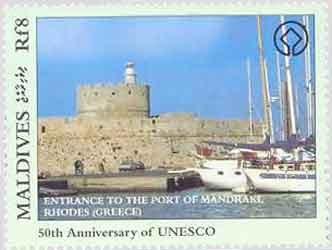
Entrance to the Port of Mandraki, Rhodes
Ιn the 19th century, the city was the capital of the Eyalet of the Archipelago, but the decline of the Ottoman Empire resulted in the general neglect of the town and its buildings, which further deteriorated due to the strong earthquakes that often plague the area.
Italian period
In 1912 Italian troops took the island over with the rest of the Dodecanese Islands, and established an Italian colony known as Isole Italiane dell'Egeo in 1923.
The Italians would later demolish the houses that were built on and around the city walls during the Ottoman era. They also turned the Jewish and Ottoman cemeteries into a green zone surrounding the Medieval Town The Italians preserved what was left from the Knights' period, and destroyed all Ottoman buildings. They also reconstructed the Grand Master's Palace. Furthermore, an Institute for the study of the History and Culture of the region was established, and major infrastructure work was done to modernize Rhodes.
Modern period
Following the Italian Armistice of 8 September 1943, the British attempted to get the Italian garrison on Rhodes to change sides. This was anticipated by the German Army, which succeeded in occupying the island with the Battle of Rhodes. In great measure, the German occupation caused the British failure in the subsequent Dodecanese Campaign.
After the armistice of Cassibile, Italy declared war on the German Empire. Thereupon troops of the Wehrmacht occupied the islands in autumn 1943. The Italian local administration on the Aegean Islands remained in place. During the time of the German occupation, mainly military installations were built, such as the positions on Mount Filerimos or the countless bunkers on the east coast. There are also some remains of an airfield of the German Air Force between Archangelos and Lindos.
Although the Jewish community on Rhodes was initially largely spared anti-Jewish measures were taken on July 13, 1944, Lieutenant General Ulrich Kleemann, the East Aegean commander stationed on the island, ordered the Jews to be imprisoned. A major reason for this order was the rapid decline in the Italian lira valid on Rhodes, which made it increasingly difficult for the German occupiers to cover the running costs for the crew and to buy the goods necessary for the troops. The Jews' belongings were therefore coveted as objects of exchange to prevent payment difficulties and supply shortages on the German side.
May 1945: People in Rhodes celebrate the surrender of the Wehrmacht
The deportation of the Rhodian Jews began on July 24, 1944. First they were brought to Piraeus by sea, from there they were transported by train to the Auschwitz-Birkenau extermination camp, where they arrived on August 16, 1944. A total of 1,673 Jewish residents were deported from Rhodes and 94 from the neighboring island of Kos. 54 Jews on Rhodes and 6 on Kos had managed to avoid deportation. Only 151 members of the community on Rhodes and 12 of those on Kos survived. In 1947 Rhodes still had 60 Jewish inhabitants, Kos only one.
Until the end of the war, Rhodes remained under German rule. However, the island was completely blocked by British naval forces and could only be insufficiently supplied from the air.
According to the newspaper Rodiaki, Rhodes was bombarded by the British army in 15th July 1940 as reported by Associated press and published in Daily mirror. An Italian army base was hit. Then followed an attack in 14th April 1941. In the bombardement in 27 September a Church in Niochori was destroyed. In the attack of 15 March, Greeks and few Jews and Italians died and the church of Archangel Michael was destroyed and also a Jewish synagogue. Other bombardments followed such as 2nd May 1942, 12th September 1943, 22th September 1943, 9th October 1943. In 17th October the Greek ship Miaoulis participated in the Attack, the medieval city was hit and 30 deads were reported that day. Finally there was a bombardement in 19th December 1944 by 10 airplanes. The bombs that fell on the medieval city of Rhodes claimed human lives and destroyed a great number of buildings, leaving large gaps in the urban tissue. One of the first Decrees of the Greek administration designated those areas as reserved for future excavations and a number of edifices as safeguarded buildings.
On 8 May 1945 the Germans under Otto Wagener surrendered Rhodes as well as the Dodecanese as a whole to the British, who soon after then occupied the islands as a military protectorate. In 1947, Rhodes, together with the other islands of the Dodecanese, was united with Greece.
In 1957, a new city plan was approved by a Decree and in 1960 the entire medieval town was designated as a protected monument by the Ministry of Culture. In 1961 and 1963 new Decrees were issued concerning the new city plan. They provided for the widening of existing streets and the opening of new ones. These were not implemented in the old city due to the resistance of the Archaeological Service. In 1988, the old town of Rhodes was designated as a World Heritage City by UNESCO.
Government
Rhodes is the capital of the island of Rhodes and of the Dodecanese Prefecture. The city hosts both the City Hall and the Prefecture Hall and as a form of recognition holds also a regional office.
Main sights
Panoramic view of Rhodes harbour.
Panoramic view of Rhodes city.
Panorama of the interior of the Grand Master's Palace.
Medieval City of Rhodes *
UNESCO World Heritage Site
RhodesIntérieurDuPalais.JPG
Country Greece
Type Cultural
Criteria ii, iv, v
Reference 493
Region ** Europe and North America
Inscription history
Inscription 1988 (12th Session)
* Name as inscribed on World Heritage List
** Region as classified by UNESCO
Street of the old city.
Holocaust memorial at the Jewish cemetery. Rhodes had a significant Jewish population until World War II.
The city is home to numerous landmarks. Some of them date back to antiquity and most of the others remain from the Knights' Period.
Grand Master's Palace (15th century)
Knights Street
Acropolis of Rhodes
Mosque of Suleiman the Magnificent
Ancient walls, created in the mid-14th century on a previous line and remade after the Ottoman siege of 1480 and the earthquake of the following year. In 1522 Suleiman entered the city from the gate of St. Anastasius
Gothic buildings in the historical upper town.
Recently, the Byzantine harbor was excavated, discovering unique medieval shipwrecks.
Demographics
Both city and island population continue to grow contrary to national levels; the city has an official population of 54,000, but the actual population is estimated between 115,000 and 120,000. This is caused by many permanent residents of the city registering in their place of birth during the census. Thus the city's total population, as counted by the census, is less than the number of people actually residing in the city. Currently it is estimated that 120,000 people reside permanently in the city although last census showed only 54,000.
| Town/Village | Population | Municipal unit | Town/Village | Population | Municipal unit |
|---|---|---|---|---|---|
| Rhodes City | 50,636 | Rhodes | Gennadi | 671 | South Rhodes |
| Ialysos | 11,331 | Ialysos | Salakos | 576 | Kameiros |
| Afantou | 6,329 | Afantou | Kritinia | 503 | Attavyros |
| Archangelos | 5,476 | Archangelos | Kattavia | 307 | South Rhodes |
| Kremasti | 5,396 | Petaloudes | Dimylia | 465 | Kameiros |
| Kalythies | 4,832 | Kallithea | Kalavarda | 502 | Kameiros |
| Koskinou | 3,679 | Kallithea | Pylona | 627 | Lindos |
| Pastida | 3,641 | Petaloudes | Istrios | 291 | South Rhodes |
| Paradeisi | 2,667 | Petaloudes | Damatria | 641 | Petaloudes |
| Maritsa | 1,808 | Petaloudes | Laerma | 361 | Lindos |
| Embonas | 1,242 | Attavyros | Apolakkia | 496 | South Rhodes |
| Soroni | 1,278 | Kameiros | Platania | 196 | Kameiros |
| Lardos | 1,380 | Lindos | Kalathos | 502 | Lindos |
| Psinthos | 853 | Kallithea | Lachania | 153 | South Rhodes |
| Malonas | 1,135 | Archangelos | Monolithos | 181 | Attavyros |
| Lindos | 3,087 | Lindos | Mesanagros | 155 | South Rhodes |
| Apollona | 845 | Kameiros | Profilia | 304 | South Rhodes |
| Massari | 1,004 | Archangelos | Arnitha | 215 | South Rhodes |
| Fanes | 858 | Kameiros | Siana | 152 | Attavyros |
| Theologos | 809 | Petaloudes | Vati | 323 | South Rhodes |
| Archipoli | 582 | Afantou | Agios Isidoros | 355 | Attavyros |
| Asklipio | 646 | South Rhodes |
Climate
Rhodes has a semi-arid hot-summer Mediterranean climate (Csa in the Köppen climate classification).
| Climate data for Rhodes | |||||||||||||
|---|---|---|---|---|---|---|---|---|---|---|---|---|---|
| Month | Jan | Feb | Mar | Apr | May | Jun | Jul | Aug | Sep | Oct | Nov | Dec | Year |
| Record high °C (°F) | 22.0 (71.6) |
22.0 (71.6) |
27.4 (81.3) |
30.6 (87.1) |
34.8 (94.6) |
36.2 (97.2) |
39.0 (102.2) |
41.2 (106.2) |
35.4 (95.7) |
33.2 (91.8) |
28.4 (83.1) |
22.8 (73.0) |
41.2 (106.2) |
| Average high °C (°F) | 15.1 (59.2) |
15.2 (59.4) |
16.8 (62.2) |
20.0 (68.0) |
24.2 (75.6) |
28.4 (83.1) |
30.5 (86.9) |
30.7 (87.3) |
28.2 (82.8) |
24.5 (76.1) |
20.1 (68.2) |
16.6 (61.9) |
22.5 (72.6) |
| Daily mean °C (°F) | 12.0 (53.6) |
12.0 (53.6) |
13.5 (56.3) |
16.3 (61.3) |
20.0 (68.0) |
24.2 (75.6) |
26.4 (79.5) |
26.7 (80.1) |
24.4 (75.9) |
20.7 (69.3) |
16.7 (62.1) |
13.5 (56.3) |
18.9 (66.0) |
| Average low °C (°F) | 8.8 (47.8) |
8.8 (47.8) |
10.1 (50.2) |
12.5 (54.5) |
15.8 (60.4) |
19.9 (67.8) |
22.3 (72.1) |
22.7 (72.9) |
20.5 (68.9) |
16.9 (62.4) |
13.2 (55.8) |
10.4 (50.7) |
15.2 (59.3) |
| Record low °C (°F) | −4.0 (24.8) |
−1.6 (29.1) |
0.2 (32.4) |
5.2 (41.4) |
8.6 (47.5) |
12.6 (54.7) |
16.8 (62.2) |
17.0 (62.6) |
10.6 (51.1) |
7.2 (45.0) |
2.4 (36.3) |
1.2 (34.2) |
−4.0 (24.8) |
| Average rainfall mm (inches) | 149.6 (5.89) |
105.7 (4.16) |
75.6 (2.98) |
27.8 (1.09) |
18.6 (0.73) |
2.3 (0.09) |
0.4 (0.02) |
0.2 (0.01) |
5.8 (0.23) |
65.5 (2.58) |
94.1 (3.70) |
157.4 (6.20) |
703 (27.68) |
| Average rainy days | 15.5 | 12.7 | 10.5 | 7.6 | 4.6 | 1.2 | 0.2 | 0.1 | 1.5 | 6.7 | 9.5 | 15.4 | 85.5 |
| Average relative humidity (%) | 70.1 | 69.1 | 68.7 | 66.5 | 64.4 | 58.5 | 57.6 | 59.9 | 61.4 | 67.5 | 71.4 | 72.4 | 65.6 |
| Mean daily sunshine hours | 5.0 | 6.0 | 7.0 | 9.0 | 11.0 | 13.0 | 14.0 | 13.0 | 11.0 | 8.0 | 6.0 | 5.0 | 9.0 |
| Percent possible sunshine | 50 | 55 | 58 | 69 | 79 | 87 | 100 | 100 | 92 | 73 | 60 | 50 | 73 |
| Source 1: Hellinic National Meteorological Service [17] | |||||||||||||
| Source 2: NOAA (Record temperature),[18] Weather Atlas (sunshine data)[19] | |||||||||||||
| Climate data for Rhodes | |||||||||||||
|---|---|---|---|---|---|---|---|---|---|---|---|---|---|
| Month | Jan | Feb | Mar | Apr | May | Jun | Jul | Aug | Sep | Oct | Nov | Dec | Year |
| Average sea temperature °C (°F) | 17.9 (64.2) |
17.0 (62.6) |
17.1 (62.8) |
17.6 (63.7) |
20.1 (68.2) |
23.4 (74.1) |
25.9 (78.6) |
27.2 (81.0) |
26.7 (80.1) |
23.8 (74.8) |
20.9 (69.6) |
18.8 (65.8) |
21.4 (70.5) |
| Mean daily daylight hours | 10.0 | 11.0 | 12.0 | 13.0 | 14.0 | 15.0 | 14.0 | 13.0 | 12.0 | 11.0 | 10.0 | 10.0 | 12.1 |
| Average Ultraviolet index | 2 | 3 | 5 | 7 | 8 | 10 | 10 | 9 | 7 | 5 | 3 | 2 | 5.9 |
| Source: Weather Atlas [19] | |||||||||||||
Education
Facilities by category:
Primary Education: 21 primary schools
Secondary Education: 7 high schools and 7 lyceums
Higher Education: Some departments of the Aegean University, Higher and Lower Tourism Schools and some private institutes
The last years two private schools were also established and offer classes from primary to lyceum education.
Transportation
Diagoras International Airport.
Laocoön and His Sons; Grand Master's Palace.
Road network
The road network of the city is gradually becoming insufficient as the car fleet expands at a rate of 5,500 per year thus making both traffic and parking an increasing concern for the city officials, especially during the high-season (about 70,000 cars move from/to the center per day). The Medieval Town closes for vehicles during the summer so all the traffic gathers outside the walls and towards the modern city center which has mainly narrow and one-way streets. Finding a parking space is difficult and moreover it is under a fee. Direction signings on the streets are sufficient. From the south end of the city begins the E-95, the national road that connects the city with Lindos.
Bus service
Bus service within the city is currently inefficient as the local municipal transport company (RODA[5]) is almost in bankruptcy. Its fleet is old and small, the routes are inconvenient and without specific timetables and finally, lack of serious management over the years undermine a probable future return in reliability and profits. Note though that during tourism season the company serves as well as possible all the main resorts and attractions contrary to winter time when services are below standard.[6]
Taxi service
Taxis in the city are plentiful during winter but are scarce in the summer due to high tourism. About 400 taxis serve the city and can be either found in specified taxi ranks or by phone.
Sea service
The city hosts four harbors; the central serves national and international traffic (ferried and cruise ships), Akandia harbor is currently in construction servicing mainly cargo ships and cruise ships on busy days, Kolona serves in-prefecture traffic and private yachts and finally Mandraki harbor services daily trips around the island and small yachts. The new Marina of the island is being constructed in the Zefyros area and is expected to be operational by 2009.
Air Service
Diagoras International Airport of Rhodes serves both city and the island. It is situated 14 km south west of the city. It is connected to all major Greek airports and Cyprus throughout the year and during tourism season accepts heavy charter traffic.[6]
Media
Television and radio
Most major nation-wide television stations broadcast in the city. There are also five local television stations and a number of local and national radio stations.
Newspapers
There are three daily newspapers issued that deal with both the city and the whole region. Moreover two are issued every Monday and there are few others with specific themes.
I Rodiaki [1] (translated "The Rhodian", daily)
I Proodos [2] (translated "Progress", daily)
I Dimokratiki [3] (translated "The Democrat", daily)
I Gnomi (translated "The Opinion", weekly)
I Drasi (translated "Action", weekly)
Sports
Diagoras Stadium in the city of Rhodes
Football: AS Rodos and Diagoras F.C. are the island's biggest teams and rivals. The latter competed in 2018–19 season at the national level third tier (Gamma Ethniki) along with GAS Ialysos and both achieved promotion to (Greek Football League). AS Rodos competed in 1st tier of local league and ranking 1st achieved promotion and is returning after one year to (Gamma Ethniki) which from 2019–20 season becomes tier 4. Local football leagues (organized at the prefecture level) contain three divisions with more than 50 teams.[57] Many stadiums are grass covered.[58]
Basketball: Colossus BC sponsors professional basketball and after more than a decade of presence in the top-level Greek Basket League this season was relegated to Greek A2 Basket League. The local league includes a single division with two groups, one for Rhodes and the other for the rest islands, with 7 and 5 teams respectively.[59] Three indoor courts exist in Rhodes City, and one each in Ialysos, Kremasti and Faliraki. Archangelos town will also get an indoor court according to Rhodes municipality planned works and regional government's approved funds.[60]
Volleyball: Rodion Athlisis managed to escape local obscurity and until 2018–19 season competed at national level second tier losing promotion to first level in play-offs for three consecutive seasons.[61] Unfortunately this unlucky streak made team sponsors to withdraw from the men's team and focus solely to developing youth academies.[62]
Water polo: mostly amateur based. There is not any single public indoor pool on the island.
Rugby: introduced in 2007. Teams compete at the national level.[citation needed]
Tennis: Rhodes Tennis Club (Ροδιακός Όμιλος Αντισφαίρισης) promotes officially tennis since 1949. Club operates on two separate locations, one downtown next to the casino and one next to Kallipateira National Athletic Centre.[63]
Sailing: Island has competed at the international level[citation needed]
Cycling: For a long period of time Rhodes had the only velodrome in Greece. For the moment, island is the seat of Dodecanissos Local Cycling Committee. Most notable cycling clubs are Rodilios CC, Diagoras GC, Elafos CC, Iviskos CC, all based in the city of Rhodes, plus Antaios SC of Kremasti and Athlos SC of Paradeisi. In Rhodes, the International Tour of Rhodes, part of UCI Europe Tour Cycling Calendar, is annually organised.
Rhodes competed in the bi-annual Island Games, which it hosted in 2007.[64] Since 2019 is suspended from competition.
Cuisine
Rhodian tradition in cuisine is rich. Koriantolino and Souma (colorless alcoholic beverage produced from grape distillation) are the main alcoholic drinks of Rhodes. Local foods include:
Escharitis, type of bread
Pitaroudia
Milla and Tsiriggia, meat fat
Pougia pie
Lakani, goat meat with chickpeas
Lópia (beans) with goat
Matsi, hand made pasta used to make Koulouría, a traditional recipe
Synoro, traditional cheese
Tahinopita
Zvigoi, type of loukoumades
Melekouni
Fanouropita
Takakia (Mantinades)
Katimeria (tiganites, pancakes)
Amygdalota, white almond cookies
Moschopougia
International relations
Pitaroudia, traditional food from Rhodes and Dodecanese.
Consulates
The city of Rhodes is also home to many foreign consulates.[7]
Austria
Belgium
Denmark
Finland
France
Germany
Hungary
Italy
Netherlands
Spain
Sweden
Turkey
United Kingdom
Twin towns — sister cities
See also: List of twin towns and sister cities in Greece
Rhodes is twinned with:
Spain Ávila, Spain
United States New Braunfels, USA
France Conches-en-Ouche, France
United States Greece, USA
Ukraine Yalta, Ukraine
Cyprus Limassol, Cyprus
Australia Perth, Australia
Mexico Puebla, Mexico
United States Rhode Island, USA
Spain Roses, Spain
Malta Valletta, Malta
Sweden Visby, Sweden
Italy Pisa, Italy
References
"Ο Δήμαρχος | Rhodes.gr".
Kallikratis law Greece Ministry of Interior (in Greek)
"Rhodes". Visit Greece.
Paul Hellander, Greece, 2008
Duncan Garwood, Mediterranean Europe, 2009
Ryan Ver Berkmoes, Oliver Berry, Geert Cole, David Else, Western Europe, 2009
Harry Coccossis, Alexandra Mexa, The challenge of tourism carrying capacity assessment: theory and practice, 2004
"SOL Search". www.cs.uky.edu.
"SOL Search". www.cs.uky.edu.
Anthony Bale, trans., The Book of Marvels and Travels, Oxford 2012, ISBN 0199600600, p. 16 and footnote
"Rhodes | island, Greece". Encyclopedia Britannica.
"Geography and Geomorphology – South Aegean". www.aegeanislands.gr.
Marco, M; Cavallaro, A; Pecchioli, E & Vernesi, C (11 November 2006), "Artificial Occurrence of the Fallow Deer, Dama dama dama (L., 1758), on the Island of Rhodes (Greece): Insight from mtDNA Analysis", Human Evolution, 21 (2): 167–175, doi:10.1007/s11598-006-9014-9
"Rhodes, Greece, 1481". Jan Kozak Collection: KZ13, The Earthquake Engineering Online Archive.
Ambraseys, N. N.; Adams, R. D. (1998). "The Rhodes earthquake of 26 June 1926". Journal of Seismology. 2 (3): 267–292. Bibcode:1998JSeis...2..267A. doi:10.1023/A:1009706415417.
"Earthquake's aftermath". Discover Rhodes. Retrieved 16 July 2008.
"Climatology – Rodos". Hellinic National Meteorological Service. Archived from the original on 25 March 2017. Retrieved 24 March 2017.
"Rhodes Climate Normals 1961–1990". National Oceanic and Atmospheric Administration. Retrieved 1 March 2015.
"Rhodes, Greece – Climate data". Weather Atlas. Retrieved 24 March 2017.
B. d'Agostino, "Funerary customs and society on Rhodes in the Geometric Period: some observations", in E. Herring and I. Lemos, eds. Across Frontiers: Etruscans, Greeks, Phoenicians and Cypriots. Studies in Honour of D. Ridgway and F.R. Serra Ridgway 2006:57–69.
Iliad 2.653–654
The Historical Library of Diodorus Siculus, Book V, ch.III. Retrieved 24 January 2010.
Sideris A., "Orientalizing Rhodian Jewellery in the Aegean", Cultural Portal of the Aegean Archipelago, Athens 2007.
A. Agelarakis"Demographic Dynamics and Funerary Rituals as Reflected from Rhodian Handra Urns", Archival Report, Archaeological and Historical Institute of Rhodes, 2005
He wrote about Jason and Medea in the Argonautica.
Boardman, 199–201
Polybius (1889). Friedrich Otto Hultsch (ed.). The Histories of Polybius. London: Macmillan & Co. pp. xxviii. 14, 15, xxix. 4, 7.
On Rhodes in antiquity see esp. R.M. Berthold, Rhodes in the Hellenistic Age, Cornell University Press, 1984.
See Acts 21.
Gregory, Timothy E. (1991). "Rhodes". In Kazhdan, Alexander (ed.). The Oxford Dictionary of Byzantium. Oxford and New York: Oxford University Press. pp. 1791–1792. ISBN 0-19-504652-8.
Kia 2016, p. 223.
Greatrex & Lieu 2005, p. 197.
Howard-Johnston 2006, p. 33.
Treadgold, Warren (1997). A History of the Byzantine State and Society. Stanford, California: Stanford University Press. p. 313. ISBN 0-8047-2630-2.
Treadgold, Warren (1997). A History of the Byzantine State and Society. Stanford, California: Stanford University Press. pp. 325, 327. ISBN 0-8047-2630-2.
Treadgold, Warren (1997). A History of the Byzantine State and Society. Stanford, California: Stanford University Press. p. 344. ISBN 0-8047-2630-2.
Brownworth, Lars (2009). Lost to the West: The Forgotten Byzantine Empire That Rescued Western Civilization. Crown. p. 233. ISBN 978-0-307-40795-5. "... the Muslims captured Ephesus in 1090 and spread out to the Greek islands. Chios, Rhodes, and Lesbos fell in quick succession."
Mueller, Edwin (1930). Die Poststempel auf der Freimarken-Ausgabe 1867 von Österreich und Ungarn.
Mueller, Edwin (1961). Handbook of Austria and Lombardy-Venetia Cancellations on the Postage Stamp Issues 1850–1864. p. 217.
"Acropolis if Rhodes:Information". Archived from the original on 5 August 2012. Retrieved 15 May 2013.
"Καθολικη Εκκλησια Τησ Ροδου". Catholicchurchrhodes.com. Retrieved 22 March 2009.
"Rodos'ta misket havası çaldı". Milliyet.
Ürkek bir siyasetin tarih önündeki ağır vebali: Oniki ada : hatalı kararlar, acı kayıplar at Google Books
"MUM GİBİ ERİYORLAR". www.batitrakya.4mg.com.
"T.C. Dışişleri Bakanlığı'ndan". Archived from the original on 3 September 2014. Retrieved 6 September 2014.
See Angel, Marc. The Jews of Rhodes: The History of a Sephardic Community. Sepher-Hermon Press Inc. and The Union of Sephardic Congregations. New York: 1978 (1st ed.), 1980 (2nd ed.), 1998 (3rd ed.).
"History of Jewish Greece". Jewishvirtuallibrary.org. Retrieved 24 January 2010.
"The Virtual Jewish History Tour — Greece". Jewishvirtuallibrary.org. Retrieved 24 January 2010.
F.Fornol: Lachania
"Population & housing census 2001 (incl. area and average elevation)" (PDF) (in Greek). National Statistical Service of Greece. Archived from the original (PDF) on 21 September 2015.
"3comma14.gr". www.3comma14.gr.
"Αναμορφώνεται τελείως το λιμάνι της Ακαντιάς". 2 September 2017.
"rhodes sea cruises". 3 September 2020.
"Αναφέρθηκε σε όλα τα έργα που εκτελεί τρεχόντως ο Δήμος". 15 June 2018.
http://www.et.gr/
"Bus schedule" (PDF). Ministry of Economy, Development and Tourism.
"ΕΠΣ Δωδεκανήσου: Αρχική Σελίδα". www.epsdod.gr.
"ΕΠΣ Δωδεκανήσου: Γήπεδα". www.epsdod.gr.
"LOCAL COMMITTEE OF DODECANESE BASKETBALL - ΤΟΠΙΚΗ ΕΠΙΤΡΟΠΗ Ε.Ο.Κ ΔΩΔΕΚΑΝΗΣΟΥ". www.12basket.gr.
"Κλειστό Αρχαγγέλου: Ένα όνειρο, έτοιμο να πάρει σάρκα και οστά! | Η ΡΟΔΙΑΚΗ". 19 July 2019.
"Α2 Ανδρών (Μπαράζ ανόδου Α' ομίλου): Απόλλων Αθηνών - Ροδίων Άθλησις 3-1 (photos)". 31 March 2018.
"Ροδίων Άθλησις - ΣΟΚ! Τέλος το Ροδίων Άθλησις - Βόλεϊ".
http://www.rhodestennis.gr/index.php?option=com_k2&view=itemlist&layout=category&task=&id=&Itemid=663
International Island Games Association website. Retrieved 27Jun08.
sete.gr
world tourism organization competitiveness ranking
Sources
Boardman, John ed., The Oxford History of Classical Art, 1993, OUP, ISBN 0198143869
Greatrex, Geoffrey; Lieu, Samuel N. C. (2005). The Roman Eastern Frontier and the Persian Wars AD 363–628. Routledge. ISBN 978-1134756469.
Howard-Johnston, J.D. (2006). East Rome, Sasanian Persia and the End of Antiquity: Historiographical and Historical Studies. Ashgate Publishing, Ltd. ISBN 978-0860789925.
Kia, Mehrdad (2016). The Persian Empire: A Historical Encyclopedia [2 volumes]: A Historical Encyclopedia. ABC-CLIO. ISBN 978-1610693912.
Nicolle, David (1996), Sassanian Armies: the Iranian Empire Early 3rd to Mid-7th Centuries AD, Stockport: Montvert, ISBN 978-1-874101-08-6
Greece :
A - B - C - D - E - F - G - H - I - J - K - L - M -
N - O - P - Q - R - S - T - U - V - W - X - Y - Z
Retrieved from "http://en.wikipedia.org/"
All text is available under the terms of the GNU Free Documentation License
| Ancient Greece
Science, Technology , Medicine , Warfare, , Biographies , Life , Cities/Places/Maps , Arts , Literature , Philosophy ,Olympics, Mythology , History , Images Medieval Greece / Byzantine Empire Science, Technology, Arts, , Warfare , Literature, Biographies, Icons, History Modern Greece Cities, Islands, Regions, Fauna/Flora ,Biographies , History , Warfare, Science/Technology, Literature, Music , Arts , Film/Actors , Sport , Fashion --- |

